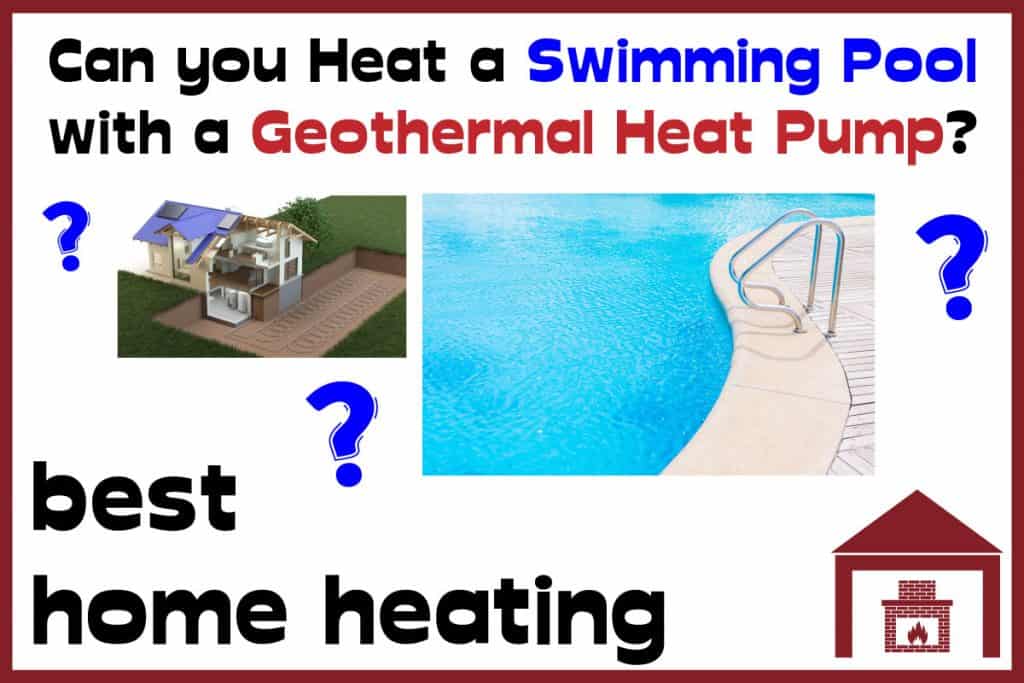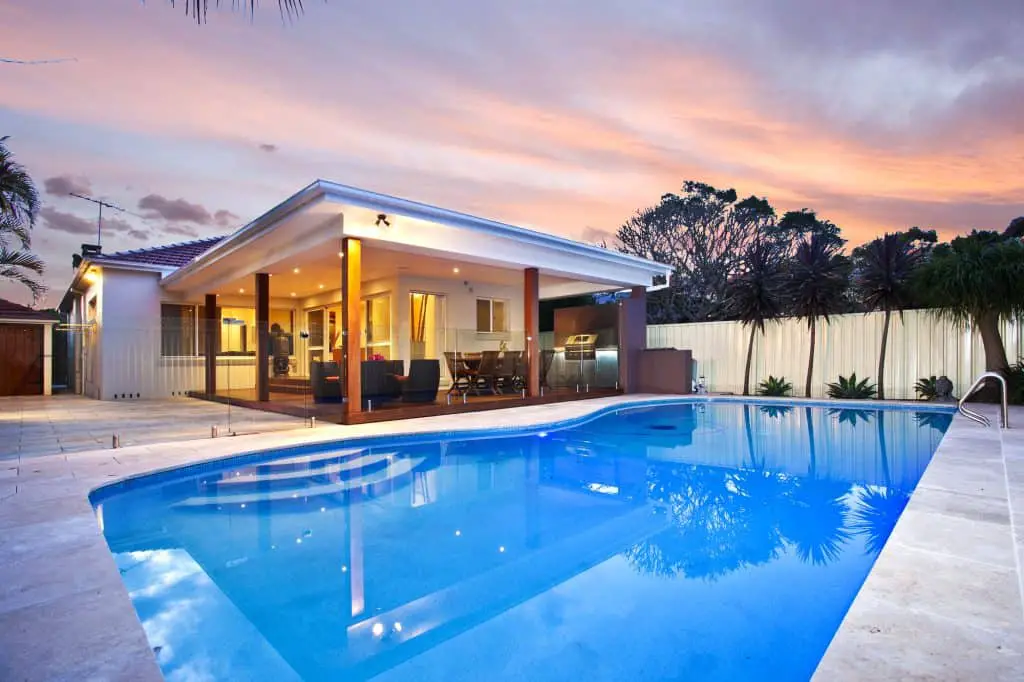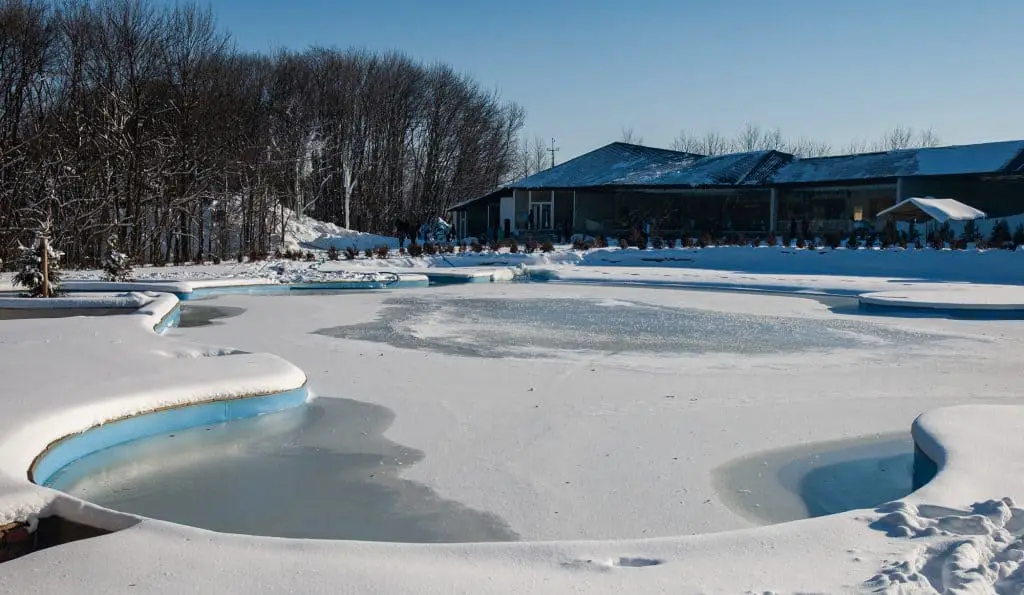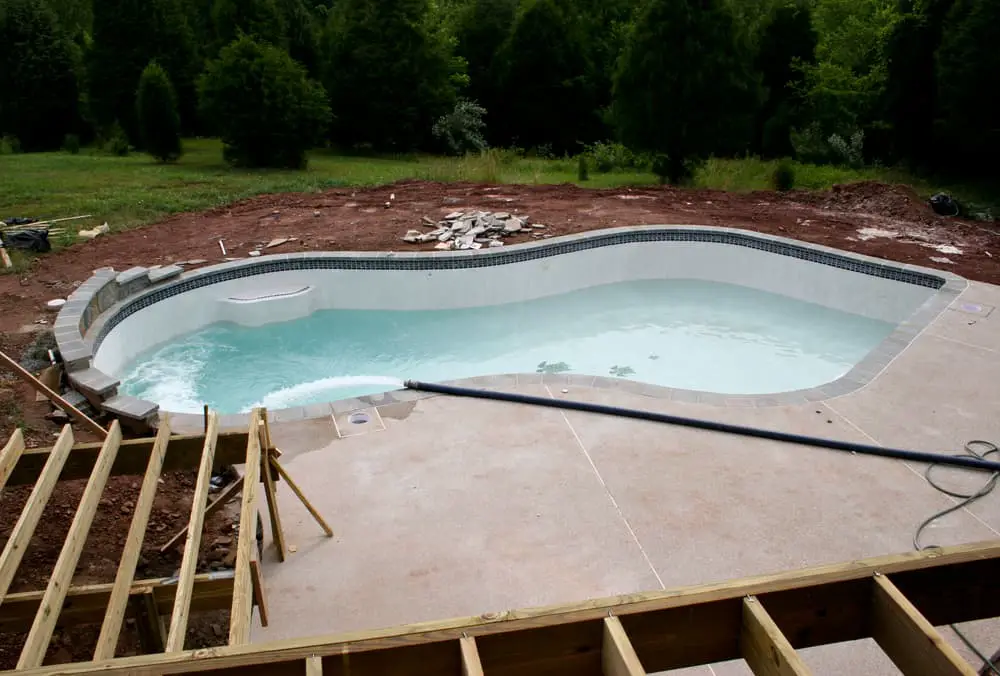Whether outdoors or indoors, swimming pools can be heated with a ground source heat pump. It is a non-fossil fuel energy source that is efficient and conserves natural resources.
A geothermal heat pump is an ideal source and method for heating a swimming pool, providing you with renewable energy pool heating for many years. Heating the pool can take time and you need enough land for the geothermal heat pump and installation can be effort and capital intensive.
Ground source heat pumps provide many benefits over conventional sources of pool heating, however there are some things you need to know before installing one to heat a swimming pool and some drawbacks to keep in mind.

How do ground source heat pumps work, and can they connect to a swimming pool?
Ground source heat pumps use thermal energy captured from the ground, which is then used to heat water that warms either your home or your pool. In order to transfer heat from the ground beneath your garden, underground pipes are laid out in either a horizontal array or inside a deep vertical borehole.
Ground source heat pumps, or geothermal heat pumps, transfer heat from an underground water source to your swimming pool’s water. This whole process occurs as follows:
- A ground source heat pump takes advantage of the sun’s energy stored underground. Underground pipes, designed to allow heat transfer through their walls, are installed to access the ground’s constant temperature.
- The fluid running through the array of ground pipes is a mixture of water and antifreeze. This mixture absorbs the low-grade heat from the ground array as it circulates. Lots of heat energy can be absorbed this way due to the length and surface area of the pipes.
- On its return to the control hub, the water-antifreeze mixture enters a heat exchanger, also known as an evaporator. The heat exchanger has two sealed-off compartments, one housing the flowing water-antifreeze mixture, and another holding a volume of refrigerant. The two liquids never mix together.
- The heat energy in the water-antifreeze mixture, which has been absorbed from the ground, then diffuses through the pipes in the heat exchanger and into the refrigerant liquid, which then boils into a gas due to its very low boiling point. The water-antifreeze mixture continues to circulate back into the ground loops for another cycle.
- The gas is then fed into a compressor, which increases the pressure of the gas and hence its temperature. This hot gas then flows into a second heat exchanger, known as the condenser. This component is very similar to the evaporator heat exchanger which transferred the heat from the water-antifreeze mixture. However, this time it transfers heat from the refrigerant gas and into a flowing water circuit circulating the water from your swimming pool.
- The refrigerant gas that has lost its heat then condenses back to a liquid as it cools beneath its boiling point. It then passes through an expansion valve, reducing the temperature and pressure and circulating back to the evaporator heat exchanger ready to meet more warmed water-antifreeze mix and to repeat the cycle.
You can learn more about how radiators combine with ground source heat pumps by watching this video from Kensa Heat Pumps on Youtube.
Does a ground source heat pump and swimming pool combination work differently?
Geothermal heat pumps operate in the same manner for heating homes and heating swimming pools. Heat is transferred in a water-to-water configuration in the swimming pool, which is the same used for hydronic floor heating systems in homes.
Do you need a specific type of ground source heat pump for a heated swimming pool?
The ground source heat pump is the same whether you are using it to heat the pool or a house. Due to the high energy requirements of the swimming pool, a ground source heat pump will require a ground loop sized to handle the load.
The unit sizes and ground collectors (either horizontal loops or borehole loops) must be sized accordingly to handle peak load demand in winter and the minimum load demand in summer without performing short start-stop cycles.
If the ground source heat pump also provides heat to the home and sanitary hot water, then you must calculate the home’s maximum demand for heat and hot water with the swimming pool’s requirements.
A ground source heat pump system consists of two main components:
- The ground array. This is either a horizontal grid of 1-2 m deep pipers or two or three at least 70-meter deep vertical boreholes. In either case, the size of the heat pump and soil conditions will determine the extent of the ground array.
- The heat pump. This is installed inside the house, which can be the size of a large filing cabinet and include a hot water cylinder.
Can ground source heat pumps heat large commercial swimming pools?
Commercial swimming pool projects can benefit greatly from ground source heat pumps. The ground loop has a lifespan of over 100 years, and the heat pump itself tends to have an average lifespan of 20+ years.
With a heat pump, you can use a public or private swimming pool to give your business green credentials, lower operating costs, and a system that lasts for years and requires little maintenance. The initial capital costs can be much higher, but they can be justified due to the long service life of geothermal heat pumps.
Geothermal Heat Pumps and Swimming Pools – Key Considerations
Will the Heat Pump have enough Heating Capacity to Heat a Pool?
Geothermal heat pumps are very green and cost-effective alternatives to electric and fuel-based heating systems, but they are not as fast to get up to warmth as the others.
It takes around 1 to 3 days to heat a swimming pool by 11 degrees Celsius (20 F). Heating a Spa for the same temperature increase can take at least an hour. So, the more water you are heating, the more time you need. With larger capacity pumps, you can do better. The heating capacity of a ground source heat pump depends on several factors:
- Air temperature
- Size of the pump
- Size of the water body to be heated
- Amount of desired heating
- Presence of insulating systems like a solar blanket

What is the Lifespan of the Pool – and what is the Lifespan of the Heat Pump?
Commercial ground source heat pumps can last for 25 years – ten years longer than combustion boilers – and the ground heat exchanger, the most expensive component of a ground source heat pump installation, should last over 100 years.
This is great peace of mind for those that want an efficient and long-lasting heating system for their swimming pool. The lifespan of geothermal systems is longer than that of other HVAC systems, but they are not immune to time’s natural wear and tear.
What Problems may you face with Ground Source Heat Pumps and Swimming Pools
Geothermal heat pumps are one of the best alternatives to conventional heating and cooling systems. It requires no fuel, it’s quiet, and it uses renewable energy sources. Sure, you have to put in some electrical energy to run the system, but you can expect around four times the amount of heating energy to be returned from the ground.
This is everything that a sustainable house owner could ever ask for. But even with all its benefits, the system has its fair share of issues too.
Corrosion in Swimming Pools – is this a killer issue for a Heat Pump?
Corrosion on any heat pump system signifies you need to replace it. Swimming pool water is treated with chlorine which can accelerate the corrosive process in a ground source heat pump system. Despite this, the lifespan of the heat pump is still long.
You should ensure the professionals installing your heat pump are aware of the potential use to heat a swimming pool. Ask them whether all of the components can handle chlorine-treated water.
Established corrosion is usually a sign that you should replace your geothermal system after reaching or exceeding 20 years of age. Older geothermal systems typically use an older refrigerant blend, R-22, which needs to be replaced with an environmentally friendly R-410A system.
Consistent Heat drop
Your geothermal heat pump may not provide as much heating as it used to. There are many possible causes, and some of them can be resolved. However, it is possible for the underground coils to be damaged, resulting in a leak of refrigerant. You should contact a heat pump professional right away if you notice a drop in heating.
Icing over a coil
A loss of refrigerant causes this problem as well. If the coils freeze over due to a refrigerant leak, they cannot absorb heat the way they should.

Are there any dangers or problems in heating a swimming pool with a geothermal heat pump?
There are no common or obvious dangers in heating a swimming pool with a geothermal heat pump, though there can always be unexpected problems that arise with any heating system.
Currently, more traditional heating systems outnumber geothermal systems. There is a limited pool of experienced contractors who install and service these systems.
Using the same ground source heat pump to heat the house through radiators and pool would result in only limited heating or longer times required for heating.
How to Troubleshoot Your Geothermal Heat Pump
Occasionally, your heat pump – swimming pool system may not run or may not produce the temperatures you expect. Most problems require professional assistance, while you can resolve a few. You can save time and money by troubleshooting your heat pump before calling a technician.
Water Supply
It is possible for your geothermal heat pump to malfunction due to a lack of water flowing through the heat exchanger or too little water flowing through the exchanger. Ensure that the loop pump is running and that the water valve is working properly and set correctly. Adjust your water flow to the correct rate.
Loop Pressure
Your geothermal heat pump components may be damaged if your loop pressure is low. Verify that the loop pressure is at the level the manufacturer recommends by looking at the pressure gauge on your system pressurizer. Call a technician to have the system pressurized. You should call an HVAC expert whenever you are unsure of the problem or the required fix.
Power Supply
If your home’s electrical panel is tripped, the system won’t run. This could be prevented by using a dedicated type “D” circuit breaker for the heat pump, as they can withstand the high starting current required for the compressor.

Conclusion – Main Considerations When Heating a Swimming Pool With a Ground Source Heat Pump
One of the smartest energy choices you can make when striving to heat your swimming pool water in an environmentally friendly manner is to use geothermal heat pumps. This type of pool heating provides the pleasure of swimming on a cool day while significantly reducing pool heating costs.
Once your geothermal heat pump is installed, you can utilize the Earth’s natural heat. To ensure working proficiency, regular but minimal maintenance is required when the thermostat is set.
Geothermal heat pumps use electricity to transfer heat rather than generate it. Although the initial installation costs (and installation effort) might be high, this method of heating your pool will save you more money in the long run. You can save up to five or six times as much by using this method of heating your pool.
Aside from swimming pools, a ground source heat pump can also be combined with your underfloor heating system to meet your home’s heating and cooling requirements.
